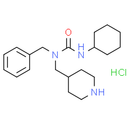Description
SRI-011381 hydrochloride is an oral bioavailabile TGF-beta signaling agonist, exhibits neuroprotective effect[1].
Product information
CAS Number: 2070014-88-7
Molecular Weight: 365.94
Formula: C20H32ClN3O
Related CAS Number:
1629138-41-5 (free base)
Chemical Name: 1-benzyl-3-cyclohexyl-1-(piperidin-4-ylmethyl)urea hydrochloride
Smiles: Cl.O=C(NC1CCCCC1)N(CC1C=CC=CC=1)CC1CCNCC1
InChiKey: GPNMJVSGNMDOJN-UHFFFAOYSA-N
InChi: InChI=1S/C20H31N3O.ClH/c24-20(22-19-9-5-2-6-10-19)23(15-17-7-3-1-4-8-17)16-18-11-13-21-14-12-18;/h1,3-4,7-8,18-19,21H,2,5-6,9-16H2,(H,22,24);1H
Technical Data
Appearance: Solid Power.
Purity: ≥98% (or refer to the Certificate of Analysis)
Solubility: DMSO: 10 mM
Shipping Condition: Shipped under ambient temperature as non-hazardous chemical or refer to Certificate of Analysis
Storage Condition: Dry, dark and -20 oC for 1 year or refer to the Certificate of Analysis.
Shelf Life: ≥12 months if stored properly.
Stock Solution Storage: 0 - 4 oC for 1 month or refer to the Certificate of Analysis.
Drug Formulation: To be determined.
HS Tariff Code: 382200
How to use
In Vitro:
SRI-011381 hydrochloride promotes fibrillar Aβ clearance by macrophages, as demonstrated by the dose-dependent decreases of Aβ in the conditioned medium derived from compound-treated macrophages[1]. SRI-011381 hydrochloride (10 μM) eliminates Saikosaponin A (SSA, 30 μM)-induced protective effects on fibroblasts[2].
In Vivo:
SRI-011381 hydrochloride protects mice against kainic acid-induced excitotoxicity and neurodegeneration[1]. SRI-011381 hydrochloride (10-75 mg/kg; p.o.; 14 days) results in significant changes in hematological endpoints, most notably reductions in red blood cells (RBCs), hematocrit and hemoglobin[1]. SRI-011381 hydrochloride (30 mg/kg; i.p.) activates TGF-β signaling in SBE-luciferase bioluminescent reporter mice[1]. SRI-011381 hydrochloride is rapidly absorbed after oral administration to FBV mice with an oral bioavailability of approximately 50%[1]. SRI-011381 hydrochloride reduces neurodegeneratio in APP751Lon, Swetransgenic mice[1].
References:
- Benzyl urea derivatives for activating tgf-beta signaling. US 20160039756 A1. 2016. Feb
- Liu Y, et al. Saikosaponin A Protects From Pressure Overload-Induced Cardiac Fibrosis via Inhibiting Fibroblast Activation or Endothelial Cell EndMT. Int J Biol Sci. 2018 Oct 31;14(13):1923-1934.
Products are for research use only. Not for human use.
Payment & Security
Your payment information is processed securely. We do not store credit card details nor have access to your credit card information.


